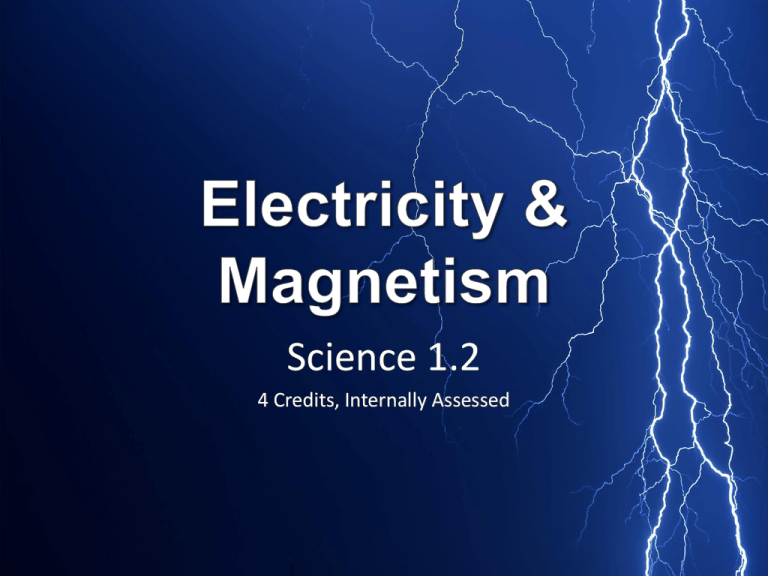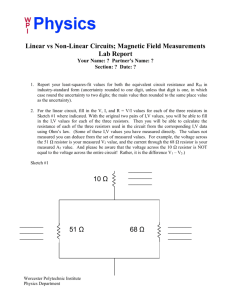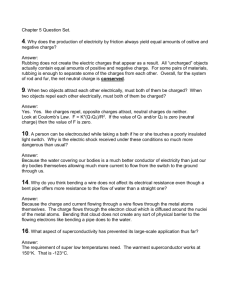Electromagnetism Powerpoint
advertisement

Science 1.2 4 Credits, Internally Assessed Static Electricity • Positive, negative and neutral charges • Conductors and insulators • Charging and discharging objects Current Electricity • Voltage, current and resistance • Parallel and series circuits • Ohm’s Law • Electrical power • Electrical safety Magnetism • Magnetic field lines • Electromagnets • Charges can be positive or negative • If an object has the same number of positive and negative charges, it is said to be electrically neutral • Opposite charges attract • Like charges repel Activity: van der Graff generator • Conductors transport charges freely • Charges spread rapidly over the surface of a conductor • Insulators do not readily transport charge • Charges on an insulator tend to stay where they are put • Both conductors and insulators can store charge Activity: Concept Map • When two objects rub past each other, charges can move from the surface of one object to the surface of the other • If a charged object comes in contact with another object, charges will be deposited on the surface of the second object • As particles in the air contact a charged object, some of the charges ‘leak’ off the object onto the particles Will a van der Graff generator work better on a humid or a dry day? Explain your answer. • If a conductor connects an object to the ground, any excess charges move off the object to the ground and the object is said to be ‘earthed’ • The symbol for earthing an object is: • A circuit has: – An energy supplier – An energy user – A conducting electrical pathway • Circuit diagrams: – Are based on the shape of rectangles – Are drawn using a ruler – Do not have gap Activity: Complete Circuit Component Table • Current is the number of charges going past a point every second • Voltage is how much energy each charge is carrying • Voltage is measured by comparing the energy per charge at two different points in a circuit • A resistor reduces the current through a circuit • Resistors convert electrical energy to heat (and sometimes light) • Ohm’s Law gives the relationship between voltage across a resistor and the current through the resistor V = IR V = voltage, V I = current, A R = resistance, W Worksheet: Ohm’s Law Aim: To determine the resistance of a bulb Method: – Set up the circuit – Use the variable resistor to vary the current through the circuit – For each value of current, measure the voltage across the bulb – Repeat for 5 values of current Results Current (A) Voltage (V) Calculated Resistance (W) Draw a graph of voltage (y-axis) vs. current (x-axis) Calculate the slope of your graph Conclusion • What was the gradient of your graph? • Compare these two equations: V = RI y = mx + c • What value does the gradient of the graph give you? • What was the resistance of your light bulb? • When resistors are in series, the total resistance is the sum of the individual resistances RT = R1 + R2 + ... RT = total resistance, W R1 = first resistor, W R2 = second resistor, W • When resistors are in parallel, the total resistance is found by adding the inverses of the individual resistances RT = total resistance, W R1 = first resistor, W R2 = second resistor, W Worksheet: Ohm’s Law Part 2 • Power is a measure of how quickly energy is converted from one form to another • Power is measured in Watts (W) • Electrical power can be calculated by P = VI P = power, W V = voltage, V I = current, A Worksheet: Power • Aim: To determine what happens to current as resistors are added in series. • Hypothesis: I think that as more resistors are added in series, the current will <increase/ decrease/stay the same> • Background Information: – • Method: – Set up a series circuit with an ammeter and one resistor – Measure the current – Repeat for two and then three resistors in series • Results: Number of Resistors in Series Current (A) 1 2 3 • Conclusion: – Agree/disagree with your hypothesis – Use your background information to explain your results • Aim: To determine what happens to temperature of water as the voltage across a heating element is increased • Hypothesis: I think that as the voltage is increased, the temperature of the water will <increase/ decrease/stay the same> • Background Information: – • Method: – Set up the circuit – Measure the temperature every minute for 10 minutes – Share your results with the class • Results: Time (min) 0 1 2 … 10 Temperature (℃ ) • Class Results: Voltage (V) Maximum Temperature (℃ ) Change in Temperature (℃ ) 2 4 6 8 10 • Conclusion: – Agree/disagree with your hypothesis – Use your background information to explain your results • Fuses and circuit breakers are safety devices • Fuses and circuit breakers break the circuit when current is too high • In NZ, mains power supply is 230 V • In USA, mains power supply is 120 V • Imagine you are writing safety advice for people moving to NZ from USA. Use your scientific knowledge to explain why it would be unsafe to use a toaster from USA in NZ. • Magnets have north and a south pole • Magnetic field lines go from north to south • Field lines do not cross • When charges move through a wire, a magnetic field forms around the wire • We use the right-hand thumb rule to work out the direction of the magnetic field: – The thumb gives the direction of conventional current – The fingers give the direction of the magnetic field • We can calculate the strength of the magnetic field using the following equation: B = magnetic field strength, Tesla, T k = a constant, 2 x 10-7 N.A-1 I = current, A d = distance, m • Demonstration: AC generator • Demonstration: Current-carrying wire and large magnet • Worksheet: Magnetic field around a currentcarrying wire • A solenoid is a coil of wire • When electrical current goes through the wire, the magnetic fields around each piece of wire add up and an electromagnet is formed • We use the right-hand thumb rule to work out the direction of the magnetic field: – The fingers give the direction of conventional current in the wires – The thumb gives the direction of the magnetic field • Research an application of electromagnets: – What is the application you have chosen? – How is an electromagnet used in this application? – Use your scientific understanding of electromagnets to explain what happens in this use of electromagnets.







